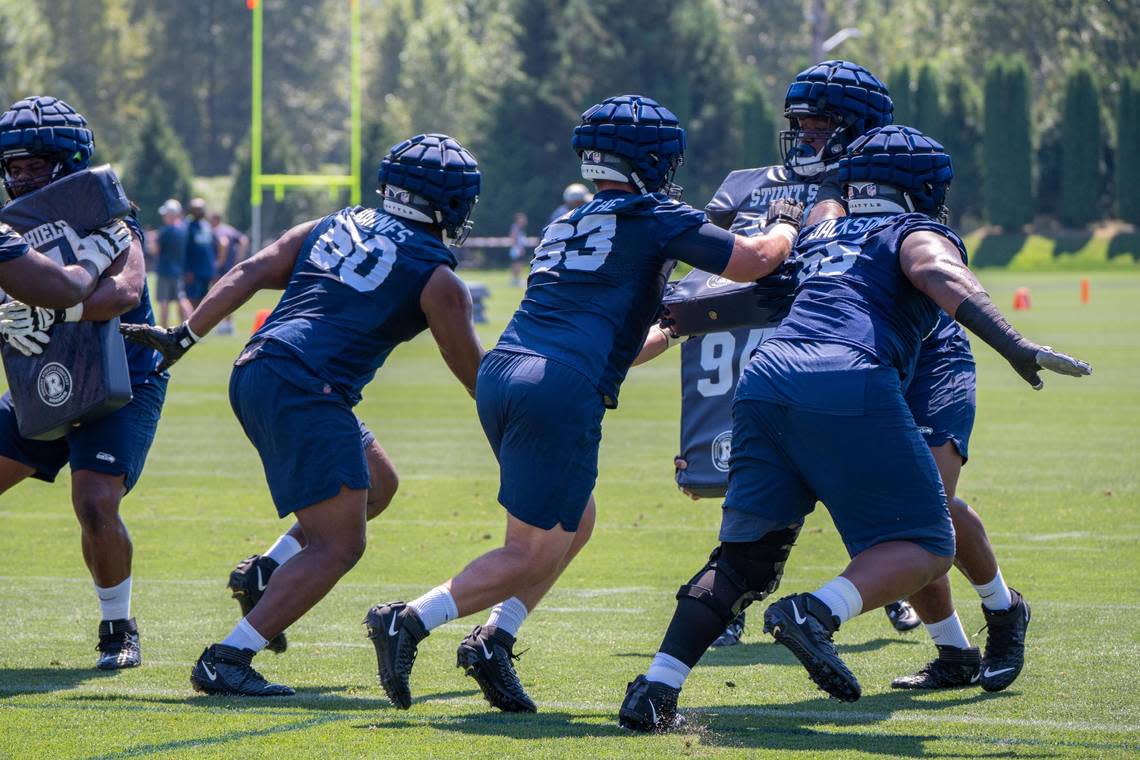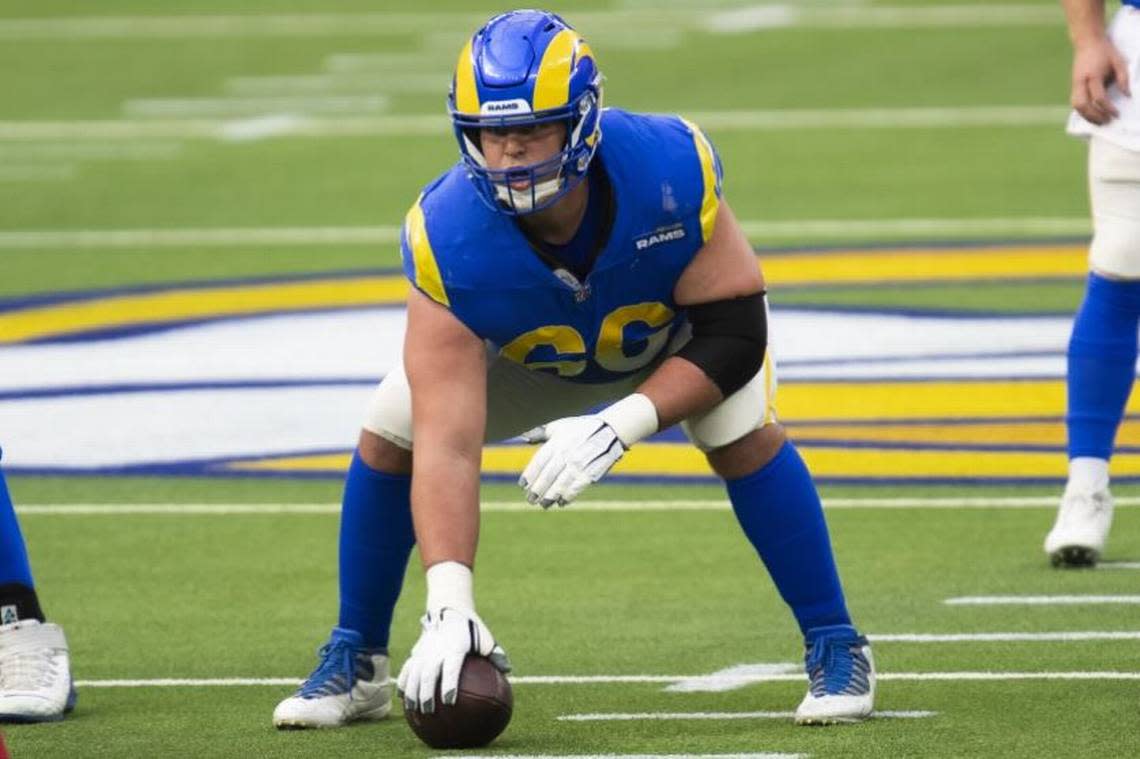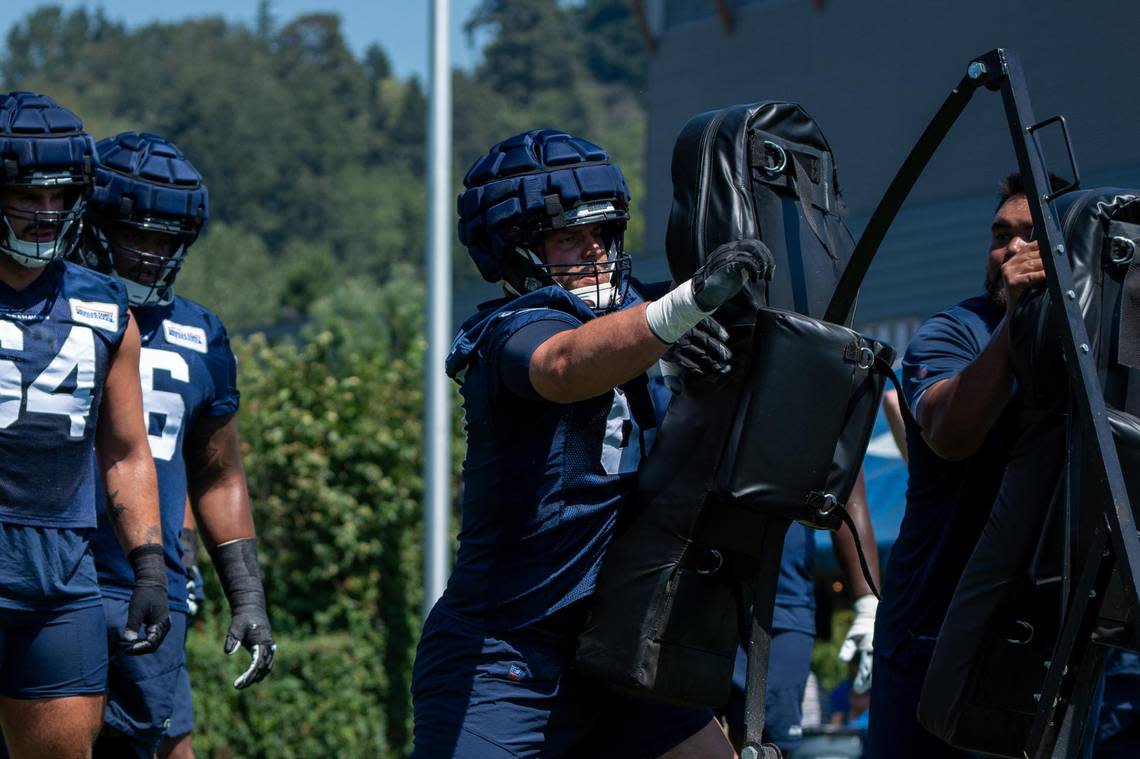Smart communication is why Austin Blythe is Seahawks’ new center. Can he fix the O-line?
Austin Blythe is the Seahawks’ new center because he is an effective and convincing communicator.
How effective and convincing?
He communicated his way through marrying the daughter of his high school football coach.
Kylie Ritchie moved with her parents to Blythe’s hometown of Williamsburg, Iowa, and became Blythe’s elementary school classmate in third grade.
Wait...anyone who’s ever played high school football knows that courting the coach’s daughter is not exactly the recommended route to romance.
“Yeah,” Blythe said, laughing on the edge of field after a recent Seahawks training-camp practice.
“There was no relationship between Kylie and me in high school. We didn’t start dating until we got to college.”
So he’s smart, too.
They became sweethearts while attending the University of Iowa together in nearby Iowa City. Blythe played football for the Hawkeyes and majored in communication studies. Ritchie majored in elementary education. She became a teacher after graduation.
Not only did the 30-year-old Blythe live to tell about marrying the daughter of veteran Williamsburg High School coach Curt Ritchie, Blythe co-owns a business with his father-in-law. He and his wife’s dad started running Legacy Acres Hunting Club on 550 acres just outside Williamsburg five years ago, about the time Blythe signed with the Rams.
Blythe and Mrs. Blythe’s dad lead an operation for hunting upland birds across fields 10 miles south of Interstate 80 outside tiny Parnell, Iowa, an hour and a half east of Des Moines. Prices start at $390 for a full day to hunt pheasants, quail and chukar. The property also has accommodations for big meals and overnight packages.
“It’s kind of a no-brainer,” Blythe, 30, said. “It’s something I can do when football’s over.
“It’s an all-around good experience.”
So is his high school football coach being able to regularly dote on the Blythes’ two children: Reed (6) and Callie (2 1/2).
Mom and the two kids are planning to move out to Seattle to be with Dad. But first, the Blythes are due to have their third child, another girl, in early October, back in Iowa.
By then, he will be a month into trying to change what has been mostly a black hole of a position for Seattle.

Center problems
The Seahawks have had mostly a mess at center in the seven years since they traded Super Bowl and Pro Bowl center Max Unger to New Orleans to get tight end Jimmy Graham. Blythe is the eighth center in seven years since they traded Unger.
The not-quite-glorious list: Patrick Lewis, Drew Nowak, Justin Britt (the most successful center, a Pro Bowl alternate in 2016), Joey Hunt, Ethan Pocic, Damien Lewis and Kyle Fuller.
Last year, after quarterback Russell Wilson famously said “I’m frustrated with getting hit too much,” coach Pete Carroll and general manager John Schneider did not upgrade the trigger spot on the offensive line that’s key to synchronized quarterback play. The Seahawks didn’t spend in what became a pricey free-agent market for centers. They didn’t draft heralded Alabama center Creed Humphrey when they could have in the second round of the 2021 draft.
They brought back Pocic and Fuller for last season. Fuller had started Seattle’s 2020 season at center. Midway through the season the Seahawks benched him and put in Pocic, a former second-round pick. It didn’t help much. Pass protection, line calls and general offensive-line play continued to be what it’s been for years in Seattle: subpar.
This offseason the Seahawks traded Wilson. They swung open the QB job to a competition between Geno Smith and Drew Lock. And they finally addressed center. Anyone who’s recently started in a Super Bowl, as Blythe did for the Rams in 2019, is a massive upgrade for Seattle — even before his first game with the team.
Blythe says he’s joined an offense that feels and plays like the Rams’ one he played on from 2017-20.
It should: Seahawks offensive coordinator Shane Waldron was Los Angeles’ tight ends coach then passing-game coordinator. Seattle offensive line coach Andy Dickerson was Blythe’s assistant offensive line coach with the Rams.
“Yes. There are major similarities,” Blythe said.
“Shane knows what works well, and that was the scheme that was run down in L.A. It’s just good football, and Shane’s a smart coach. You know, why wouldn’t he install that scheme here?
“It’s been fun to get back into this system and hit the ground running here in camp.”
Dickerson was Waldron’s close friend from their days as college teammates at Tufts University in Boston in the early 2000s. Then they both became Rams assistants under coach Sean McVay.
Dickerson said Blythe’s ability to communicate protection calls with the quarterback to the rest of the offensive line is the primary reason he’s Seattle’s new center.

“He has had a history with similar offenses,” Dickerson said. “(Plus) his communication skills with guards. He has played guard and center in this system, so he has the ability to talk to the centers, guards, and tackles because he has hit different types of blocks with multiple different guys. The right tackle may hit it one way — and as you see, we have different guys rolling in every time.
“It’s understanding the different combinations, the communication, ask(ing) good questions. So that experience, just bringing that and working with everybody.”
Blythe says Waldron’s system is the one that best suits him.
“This is a heavy zone-scheme offense, and that’s just who I am,” he said. “That’s what I do best. That’s what I did in college. I think that’s why it was such a good fit in L.A. — and why it’s been a good fit here so far in Seattle.”
Then again, it’s not as if he had a choice.
Blythe signed a one-year, $990,000 contract before the 2021 season with Kansas City. In training camp 12 months ago, Blythe had to have surgery for a hernia. He was out about a month. That’s when Humphrey won Kansas City’s center job for all of last season. That was the end of Blythe’s chance to play for the Chiefs.
Left unsigned, he shopped in free agency in March. The cupboards were absolutely bare for him.
“Seattle was my only option,” he said.
That made the choice rather easy. He signed with the Seahawks for one year and $4 million, with $2.5 million guaranteed.

Seahawks’ unique culture
Blythe is like most veterans who join the Seahawks for the first time: He’s blown away by Carroll’s environment.
It’s constant, blaring rap and old-school music through meetings and practices. It’s free-throw shooting contests between offensive and defensive players inside the main auditorium before film sessions. It’s superstar guests at practices, from the late NBA legend Bill Russell to world-renowned astrophysicist Neil deGrasse Tyson to rap star Kendrick Lamar.
It ain’t Iowa.
“It is definitely different here. The culture here is different. And different is not bad,” Blythe said. “It’s great. I love it.
“I came here, and it’s new. Something I’d never seen before, and I love it. It keeps the players happy, keeps them enjoying what they do, keeps them wanting to come back to work. And he’s been doing it a long time, had a lot of success with it.
“It’s very much a peer-to-peer-type relationship, less a coach-to-player, top-down mentality. Everyone’s the same. Everyone’s equal. Everyone’s got a voice.”
Chip on his shoulder
Carroll cultivates guys who feel slighted by previous teams and circumstances. He built a Super Bowl champion 10 years ago out of those guys. Richard Sherman and Kam Chancellor were mad they didn’t get drafted until the fifth round. Wilson was offended by the football world telling him he was too short to play quarterback in the NFL. Doug Baldwin, Jermaine Kearse, Michael Bennett went undrafted.
The pattern continues with Blythe.
He said his three forays into free agency have been the same: only one team interested, only short, no-security deals.
“I just came into the league like that a little, just being an undersized, written-off, below-average athletic ability, all that stuff. Short. Short arms. Underweight. All that stuff,” he said.
Blythe was a seventh-, final-round draft choice by Indianapolis in 2016. His scouting combine measurements that year: 6 feet 2, 291 pounds, 31 1/2-inch arms. The average NFL offensive linemen across all positions — center, guard and tackle — is 6-5, 314 pounds. with 32 1/2-inch arms.
“I just try to carry all that with me,” Blythe said, “and not take any of this for granted being in the NFL.”
